
The wrist is a complex joint, with multiple articulations. In addition to the bony complexity of the joint, three major nerves cross the wrist (median nerve, radial nerve, and ulnar nerve), as well as two major arteries (radial artery and ulnar artery) and over 20 tendons. Because of the complex anatomy of the wrist, a wrist specialist is often recommended to treat wrist fractures.
Overall, the wrist is comprised of 10 bones, and the most common area for fractures is the distal radius. The radius is one of two bones in the forearm, and the part where the radius meets the wrist is the distal radius.
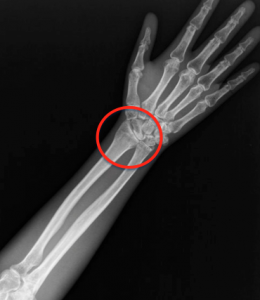
Distal radius
Who gets distal radius fractures?
Fractures of the distal radius generally occur within two groups of people. The first group is clustered in the 20–30 year age bracket; the second later in life over the age of 60. Younger individuals often have strong bones and a considerable amount of force is required to fracture the distal radius in a young, healthy person. Younger people may fracture their distal radius during a mishap such as falling off a skateboard or from a motor vehicle accident.
Many of the fractures in those over age 60 are related to osteoporosis. Osteoporosis causes the bones to weaken, and a fracture of the wrist can occur with relatively minor trauma, such as a fall from standing height on to your outstretched wrist.
Regardless of age, fractures of the distal radius are some of the most common fractures seen in the emergency room today.
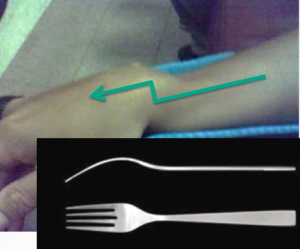
Example of displaced distal radius fracture or “dinner fork” deformity
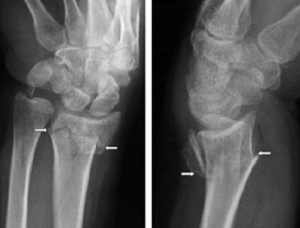
X-rays of a displaced distal radius fracture
Presentation and diagnosis
Fracturing the distal radius is highly painful and usually causes swelling. In most cases, the bone is broken but still relatively well-aligned.
Less commonly, the bones are shifted out of place (displaced), causing an obvious deformity. Deformity creates a stretch on the tendons, nerves, and arteries and usually requires a reduction (pushing the bones back into place). Because most distal radius fractures result from a fall onto your outstretched wrist, the hand is usually forced back. This presentation is often called a “dinner fork” deformity.
How are distal radius fractures treated?
Typically, fractures of the distal radius are best managed urgently in the emergency room or in the orthopaedic surgeon’s office, both facilities that are equipped to treat these injuries. A series of X-rays is standard to diagnose the injury, and in some circumstances, a CT scan is needed to gain a better view of the wrist fracture.
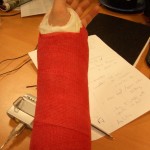
A cast to immobilize a distal radius fracture
For non-displaced fractures and minimally displaced fractures, the treatment is often as simple as a splint or a cast. Lightweight and waterproof fiberglass casts are common, and can simplify bathing and even swimming.
Displaced fractures may be treated with a “closed reduction,” in which the bones are pushed back into place. If this is required, medicine is administered to maximize patient comfort, and a splint or cast is applied after the reduction. This can be performed in the office or ER, and a stay in the hospital is not required.
Surgery is recommended if the bone is shifted in a way that it would severely compromise function of the wrist in the future. The most common surgical method utilizes titanium or steel plates and screws underneath the skin to hold the fracture in the correct position. This procedure can usually be performed on an outpatient basis and affords a rapid and reliable return to function in most cases.
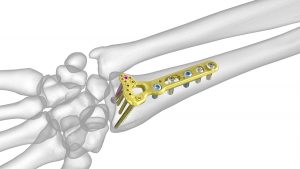
Internal plates and screws for fixing a distal radius fracture
How can distal radius fractures be prevented?
The best way to prevent distal radius fractures is with a safe, active lifestyle and a healthy diet. Bones respond to external forces by becoming stronger. Weight-bearing exercises like running and weightlifting are critical to maintaining strong, healthy bones.

Calcium and vitamin D are critical for maintaining healthy bones
Additionally, the recommended daily allowance of vitamin D and calcium, as well as an appropriate amount of sunlight, will enhance bone health and bone strength.
A DEXA (dual-energy x-ray absorptiometry) scan is a test used to detect osteoporosis. One-third of white women over the age of 65 have osteoporosis, putting them at greater risk for fractures. If you are diagnosed with osteoporosis, your doctor may recommend medication to treat the condition. These medications are beneficial in reducing the incidence of fractures among those with osteoporosis.
Summary
- The large majority of distal radius fractures can be treated with simple cast immobilization.
- Unstable fractures may require surgery.
- After appropriate treatment of distal radius fracture, most people resume their pre-injury activities without any pain.
- The best way to prevent distal radius fractures is by having an active lifestyle and following a healthy diet.
 Dr. David P. Moss is an orthopaedic surgeon at Washington Orthopaedics & Sports Medicine, with specializations in conditions of the hand, wrist, and elbow. He is certified by the American Board of Orthopaedic Surgery and the American Society for Surgery of the Hand. Dr. Moss’ research interests include tennis elbow, carpal tunnel syndrome, and post-operative pain relief.
Dr. David P. Moss is an orthopaedic surgeon at Washington Orthopaedics & Sports Medicine, with specializations in conditions of the hand, wrist, and elbow. He is certified by the American Board of Orthopaedic Surgery and the American Society for Surgery of the Hand. Dr. Moss’ research interests include tennis elbow, carpal tunnel syndrome, and post-operative pain relief.
Want to know more?
For more information about wrist fractures, email us or request an appointment.
Be sure to follow us on Facebook and Twitter as well!
